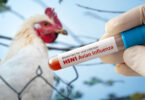In the last WinePress report, we documented that the CDC had to admit that there has been a whopping decrease of the flu virus this year, by 98% based off laboratory specimens that were sent to them and examined.
However, from their report showing their admission to these facts, in the discussion section of the article, said that there was evidence to suggest that face masks help stop the spread of the influenza virus.
Here is the discussion section of that article:
In the United States, influenza virus circulation declined sharply within 2 weeks of the COVID-19 emergency declaration and widespread implementation of community mitigation measures, including school closures, social distancing, and mask wearing, although the exact timing varied by location (2). The decline in influenza virus circulation observed in the United States also occurred in other Northern Hemisphere countries (3,4) and the tropics (5,6), and the Southern Hemisphere temperate climates have had virtually no influenza circulation. Although causality cannot be inferred from these ecological comparisons, the consistent trends over time and place are compelling and biologically plausible. Like SARS-CoV-2, influenza viruses are spread primarily by droplet transmission; the lower transmissibility of seasonal influenza virus (R0 = 1.28) compared with that of SARS-CoV-2 (R0 = 2–3.5) (7) likely contributed to a more substantial interruption in influenza transmission. These findings suggest that certain community mitigation measures might be useful adjuncts to influenza vaccination during influenza seasons, particularly for populations at highest risk for developing severe disease or complications.
Initially, declines in influenza virus activity were attributed to decreased testing, because persons with respiratory symptoms were often preferentially referred for SARS-CoV-2 assessment and testing. However, renewed efforts by public health officials and clinicians to test samples for influenza resulted in adequate numbers tested and detection of little to no influenza virus. Further, some countries, such as Australia, had less stringent criteria for testing respiratory specimens than in previous seasons and tested markedly more specimens for influenza but still detected few with positive results during months when Southern Hemisphere influenza epidemics typically peak. A new Food and Drug Administration–approved multiplex diagnostic assay for detection of both SARS-CoV-2 and influenza viruses could improve future surveillance efforts (https://www.cdc.gov/coronavirus/2019-ncov/lab/multiplex.html).
It is difficult to separate the effect that individual community mitigation measures might have had on influenza transmission this season. Although school-aged children can drive the spread of influenza, the effectiveness of school closures alone is not clear because adults have other exposures (8). There is evidence to support the use of face masks by infected persons to reduce transmission of viral respiratory illnesses to others and growing evidence to support their use (in the health care setting, in households, and in the community) to protect the healthy wearer from acquiring infection. More data are needed to assess effectiveness of different types of masks in different settings (9). Data from the current pandemic might help answer critical questions about the effect of community mitigation measures on transmission of influenza or other respiratory diseases. In addition, assessing acceptability of effective measures would be critical, because acceptability is likely to be inversely correlated with the stringency of the measure.
The findings in this report are subject to at least four limitations. First, an ecologic analysis cannot demonstrate causality, although the consistency of findings across multiple countries is compelling. Second, other factors, such as the sharp reductions in global travel or increased vaccine use, might have played a role in decreasing influenza spread; however, these were not assessed. Third, viral interference might help explain the lack of influenza during a pandemic caused by another respiratory virus that might outcompete influenza in the respiratory tract (10). This possibility is less likely in the United States because influenza activity was already decreasing before SARS-CoV-2 community transmission was widespread in most parts of the nation. Finally, it is possible that the declines observed in the United States were just the natural end to the influenza season. However, the change in the decrease percent positivity after March 1 was dramatic, suggesting other factors were at play.
The global decline in influenza virus circulation appears to be real and concurrent with the COVID-19 pandemic and its associated community mitigation measures. Influenza virus circulation continues to be monitored to determine if the low activity levels persist after community mitigation measures are eased. If extensive community mitigation measures continue throughout the fall, influenza activity in the United States might remain low and the season might be blunted or delayed. In the future, some of these community mitigation measures could be implemented during influenza epidemics to reduce transmission, particularly in populations at highest risk for developing severe disease or complications. However, in light of the novelty of the COVID-19 pandemic and the uncertainty of continued community mitigation measures, it is important to plan for seasonal influenza circulation this fall and winter. Influenza vaccination for all persons aged ≥6 months remains the best method for influenza prevention and is especially important this season when SARS-CoV-2 and influenza virus might cocirculate (1).
The Evidence
So you can see the comical double-speak all throughout those paragraphs, as the CDC tries to downplay the obvious reality that covid-19 is just being diagnosed as the flu: which means that would bring the number of covid deaths and cases down exponentially, thereby proving that it is nowhere even remotely close to being as deadly as the hype has been. For all we know, there is no actual “covid-19;” or it is real, but incredibly underwhelming in its effects.
Besides that, I underlined the part where they mention that there is evidence that face masks stop the spread of influenza. This is, however, a blatant contradiction to a previous report released this year.
In a report posted on May 5th, 2020, the CDC released a study entitled “Nonpharmaceutical Measures for Pandemic Influenza in Nonhealthcare Settings—Personal Protective and Environmental Measures.” This report collected data spanning from 1946 to July 27th, 2018 of the effectiveness of face masks in reducing laboratory-confirmed influenza. Here is what they said:
In pooled analysis, we found no significant reduction in influenza transmission with the use of face masks.
Two studies in university settings assessed the effectiveness of face masks for primary protection by monitoring the incidence of laboratory-confirmed influenza among student hall residents for 5 months (9,10). The overall reduction in ILI or laboratory-confirmed influenza cases in the face mask group was not significant in either studies.
None of the household studies reported a significant reduction in secondary laboratory-confirmed influenza virus infections in the face mask group.
Disposable medical masks (also known as surgical masks) are loose-fitting devices that were designed to be worn by medical personnel to protect accidental contamination of patient wounds, and to protect the wearer against splashes or sprays of bodily fluids (36). There is limited evidence for their effectiveness in preventing influenza virus transmission either when worn by the infected person for source control or when worn by uninfected persons to reduce exposure. Our systematic review found no significant effect of face masks on transmission of laboratory-confirmed influenza.
There are still few uncertainties in the practice of face mask use, such as who should wear the mask and how long it should be used for.
We did not find evidence that surgical-type face masks are effective in reducing laboratory-confirmed influenza transmission, either when worn by infected persons (source control) or by persons in the general community to reduce their susceptibility (Figure 2). However, as with hand hygiene, face masks might be able to reduce the transmission of other infections and therefore have value in an influenza pandemic when healthcare resources are stretched.
Are you surprised that the CDC contradicted itself? Post your thoughts below. I know I am not. The CDC has been pushing propaganda and false science for quite a long time, so it is no surprise when they are faced with crystal clear facts that destroy their propaganda, they must still do more damage control.
[20] O Timothy, keep that which is committed to thy trust, avoiding profane and vain babblings, and oppositions of science falsely so called: [21] Which some professing have erred concerning the faith. Grace be with thee. Amen. The first to Timothy was written from Laodicea, which is the chiefest city of Phrygia Pacatiana.1 Timothy 6:20-21
This is the same CDC that admitted in September that 94% percent of covid deaths had other preexisting health conditions. And the strong majority of those that died were considered to be in advanced age. Of course the “fact checkers” within hours of the news drop tried to twist the facts, and the CDC buried the report on its website.
The WinePress needs your support! If God has laid it on your heart to want to contribute, please prayerfully consider donating to this ministry. If you cannot gift a monetary donation, then please donate your fervent prayers to keep this ministry going! Thank you and may God bless you.







